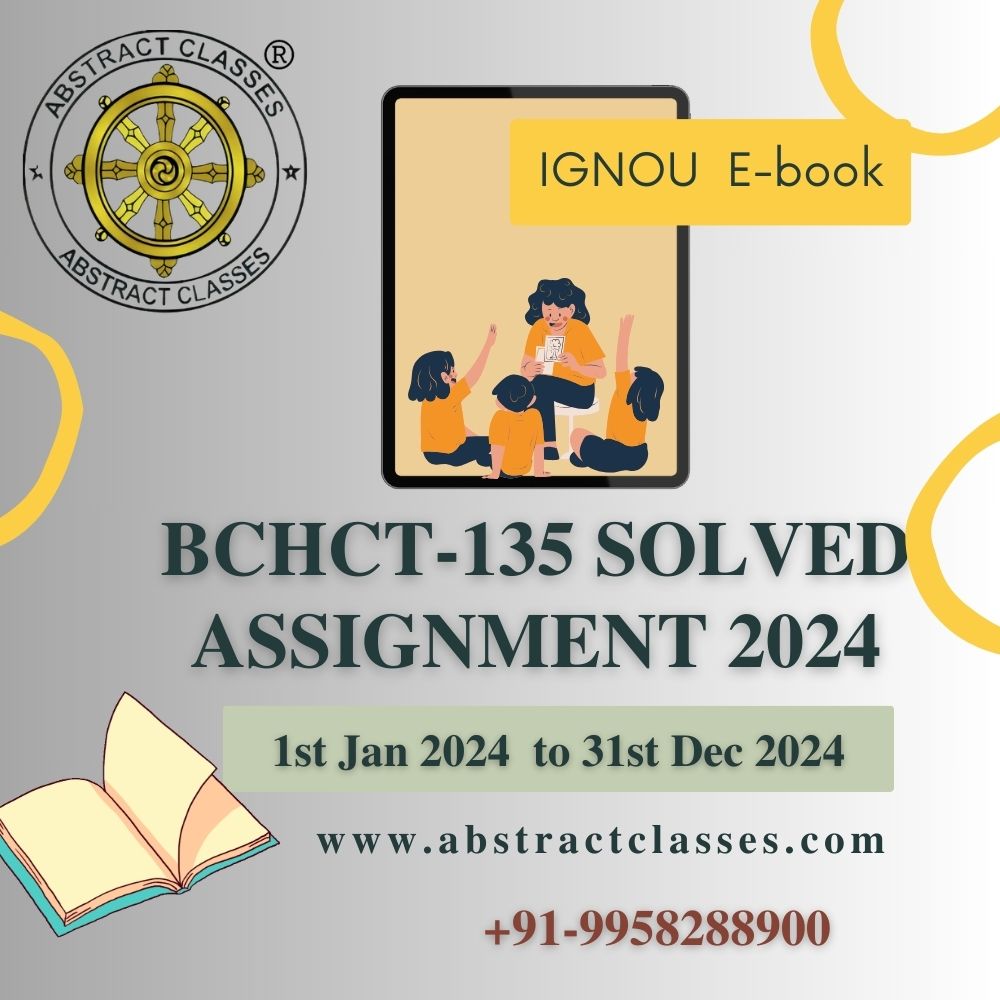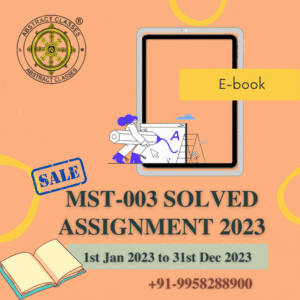
IGNOU BCHCT-135 Solved Assignment 2024 | B.Sc. CBCS Chemistry
₹49.00
Please read the following points before ordering this IGNOU Assignment Solution.
Share with your Friends
IGNOU BCHCT-135 Assignment Question Paper 2024
bchct-135-solved-assignment-2024-qp-70f87f73-d018-4ab3-a508-bab17216331a
- Discuss the fractional distillation for a mixture of benzene and toluene using a suitable diagram.
- (a) Give the thermodynamic derivation of distribution law.
(b) Write any two applications of solvent extraction. - (a) Derive the expression for distribution coefficient when the solute dissociates is one of the solvents.
(b) Differentiate between true, metastable and unstable equilibria giving suitable examples. - (a) State Gibbs phase rule and give its mathematical form.
(b) How many components are there in the following systems? Briefly discuss.
(i)CaCO_(3)⇌CaO+CO_(2) \mathrm{CaCO}_3 \rightleftharpoons \mathrm{CaO}+\mathrm{CO}_2
(ii)CH_(3)COOH+C_(2)H_(5)OH⇌CH_(3)COOC_(2)H_(5)+H_(2)O \mathrm{CH}_3 \mathrm{COOH}+\mathrm{C}_2 \mathrm{H}_5 \mathrm{OH} \rightleftharpoons \mathrm{CH}_3 \mathrm{COOC}_2 \mathrm{H}_5+\mathrm{H}_2 \mathrm{O} - (a) Calculate the maximum number of phases and maximum number of degrees of freedom that
(b) Can exist for a one-component system.
When is a system called invariant? Illustrate with an example. - Draw and explain the phase diagram of sulphur.
- (a) Define conductivity. Give its SI units.
(b) List various factors on which the conductivity of electrolytic solutions depends. - Draw and explain the conductometric titration curves for the titration of the following:
(i)HCl \mathrm{HCl} NaOH \mathrm{NaOH}
(ii)CH_(3)COOH \mathrm{CH}_3 \mathrm{COOH} NaOH \mathrm{NaOH} - (a) List the functions of a salt bridge.
(b) What are the conditions which a reversible cell should satisfy. - (a) What is an electrolyte concentration cell? Write the expression for
E_(“cell “) E_{\text {cell }}
(b) cell.
Write the reactions occurring at electrodes in the electrolysis of water. Why are a few drops of conc.H_(2)SO_(4) \mathrm{H}_2 \mathrm{SO}_4
- Discuss the two methods of decarboxylation of carboxylic acids and comment on the nature of products formed.
- How can you propane the following compound starting from ethanoyl chloride?

(iii)
13. Briefly explain Hofmann elimination. Also give the importance of this reaction.
14. Differentiate between Sandmeyer reaction and Gattermann reaction giving suitable examples.
15. Discuss the Hinsberg test for distinguishing primary, secondary and tertiary amines.
16. (a) Discuss the preparation of 2-aminobutanoic acid using Strecker synthesis.
(b) What is cope elimination? Give reaction.
17. (a) Briefly explain this general structure and classification of peptides.
(b) What is bradykinin? Give its role?
18. How is
19. (a) Explain the cyctic hemiacetal formation by glucose.
(b) Explain mutarotation in glucose.
20. Discuss the important features of structure of cellulose giving suitable diagram.
BCHCT-135 Sample Solution 2024
bchct-135-solved-assignment-2024-ss-b0a87631-f2d0-400e-939b-0b99078c2d98
- Discuss the fractional distillation for a mixture of benzene and toluene using a suitable diagram.
1. Introduction to the Components: Benzene and Toluene
- Benzene (C₆H₆): Boiling Point ≈ 80.1°C
- Toluene (C₇H₈): Boiling Point ≈ 110.6°C
2. Principle of Fractional Distillation
3. Setup for Fractional Distillation
- A distillation flask containing the mixture.
- A fractionating column, which provides a surface area for repeated vaporization and condensation.
- A thermometer to monitor the temperature.
- A condenser where vapors are cooled and condensed back into liquid.
- Collection flasks for the separated components.
4. Process of Fractional Distillation for Benzene and Toluene
- Heating the Mixture: The mixture of benzene and toluene is heated. Benzene, with its lower boiling point, starts to vaporize first.
- Vapor Rises Through Fractionating Column: The vapor enters the fractionating column. As it rises, it cools and condenses on the packing material.
- Re-Vaporization and Condensation: The condensed vapor may re-vaporize as it absorbs heat from the rising vapors. This process of repeated vaporization and condensation separates the more volatile component (benzene) from the less volatile one (toluene).
- Collection of Benzene: When the temperature at the top of the column reaches the boiling point of benzene, the vapor at this stage is almost pure benzene. It is then condensed and collected in a separate flask.
- Collection of Toluene: After all benzene has been distilled off, the temperature rises to the boiling point of toluene. The process is continued to collect toluene in a different flask.
5. Diagram of Fractional Distillation

6. Conclusion
- (a) Give the thermodynamic derivation of distribution law.
1. Introduction to the Concept
2. Thermodynamic Basis
3. Derivation
4. Conclusion
1. Metal Purification and Recovery
- Example: Copper Extraction
- In the hydrometallurgical processing of copper ores, solvent extraction is used to separate copper from other metal ions in a leach solution. The copper is selectively extracted into an organic solvent, leaving behind impurities in the aqueous phase. After extraction, the copper is transferred from the organic solvent into an aqueous solution from which it can be electrowon.
- This process is known as the solvent extraction-electrowinning (SX-EW) process and is used to produce high-purity copper from low-grade oxide ores, which are not suitable for direct smelting.
2. Pharmaceutical and Biochemical Applications
- Example: Extraction of Natural Products
- Many natural products, such as essential oils, alkaloids, and antibiotics, are extracted from plant or microbial sources using solvent extraction. The choice of solvent is crucial and depends on the solubility of the target compound and the matrix of the source material.
- For instance, the extraction of essential oils from plant materials (like lavender or eucalyptus) often involves using a non-polar solvent to dissolve the oil, followed by separation from the aqueous phase. This method allows for the recovery of concentrated extracts without the degradation of heat-sensitive components, which is a risk in distillation methods.
Conclusion
Frequently Asked Questions (FAQs)
You can access the Complete Solution through our app, which can be downloaded using this link:
Simply click “Install” to download and install the app, and then follow the instructions to purchase the required assignment solution. Currently, the app is only available for Android devices. We are working on making the app available for iOS in the future, but it is not currently available for iOS devices.
Yes, It is Complete Solution, a comprehensive solution to the assignments for IGNOU. Valid from January 1, 2023 to December 31, 2023.
Yes, the Complete Solution is aligned with the IGNOU requirements and has been solved accordingly.
Yes, the Complete Solution is guaranteed to be error-free.The solutions are thoroughly researched and verified by subject matter experts to ensure their accuracy.
As of now, you have access to the Complete Solution for a period of 6 months after the date of purchase, which is sufficient to complete the assignment. However, we can extend the access period upon request. You can access the solution anytime through our app.
The app provides complete solutions for all assignment questions. If you still need help, you can contact the support team for assistance at Whatsapp +91-9958288900
No, access to the educational materials is limited to one device only, where you have first logged in. Logging in on multiple devices is not allowed and may result in the revocation of access to the educational materials.
Payments can be made through various secure online payment methods available in the app.Your payment information is protected with industry-standard security measures to ensure its confidentiality and safety. You will receive a receipt for your payment through email or within the app, depending on your preference.
The instructions for formatting your assignments are detailed in the Assignment Booklet, which includes details on paper size, margins, precision, and submission requirements. It is important to strictly follow these instructions to facilitate evaluation and avoid delays.
Terms and Conditions
- The educational materials provided in the app are the sole property of the app owner and are protected by copyright laws.
- Reproduction, distribution, or sale of the educational materials without prior written consent from the app owner is strictly prohibited and may result in legal consequences.
- Any attempt to modify, alter, or use the educational materials for commercial purposes is strictly prohibited.
- The app owner reserves the right to revoke access to the educational materials at any time without notice for any violation of these terms and conditions.
- The app owner is not responsible for any damages or losses resulting from the use of the educational materials.
- The app owner reserves the right to modify these terms and conditions at any time without notice.
- By accessing and using the app, you agree to abide by these terms and conditions.
- Access to the educational materials is limited to one device only. Logging in to the app on multiple devices is not allowed and may result in the revocation of access to the educational materials.
Our educational materials are solely available on our website and application only. Users and students can report the dealing or selling of the copied version of our educational materials by any third party at our email address (abstract4math@gmail.com) or mobile no. (+91-9958288900).
In return, such users/students can expect free our educational materials/assignments and other benefits as a bonafide gesture which will be completely dependent upon our discretion.
Related products
-
IGNOU Assignment Solution
IGNOU MPC-001 Solved Assignment 2022-2023 | MAPC | Cognitive Psychology, Learning and Memory
₹101.00 Go to the App -
IGNOU Assignment Solution
IGNOU MEG-15 Solved Assignment 2022-2023 | MEG | Comparative Literature: Theory and Practice
₹101.00 Go to the App -
IGNOU Assignment Solution
IGNOU MEG-07 Solved Assignment 2022-2023 | MEG | INDIAN ENGLISH LITERATURE
₹101.00 Go to the App




